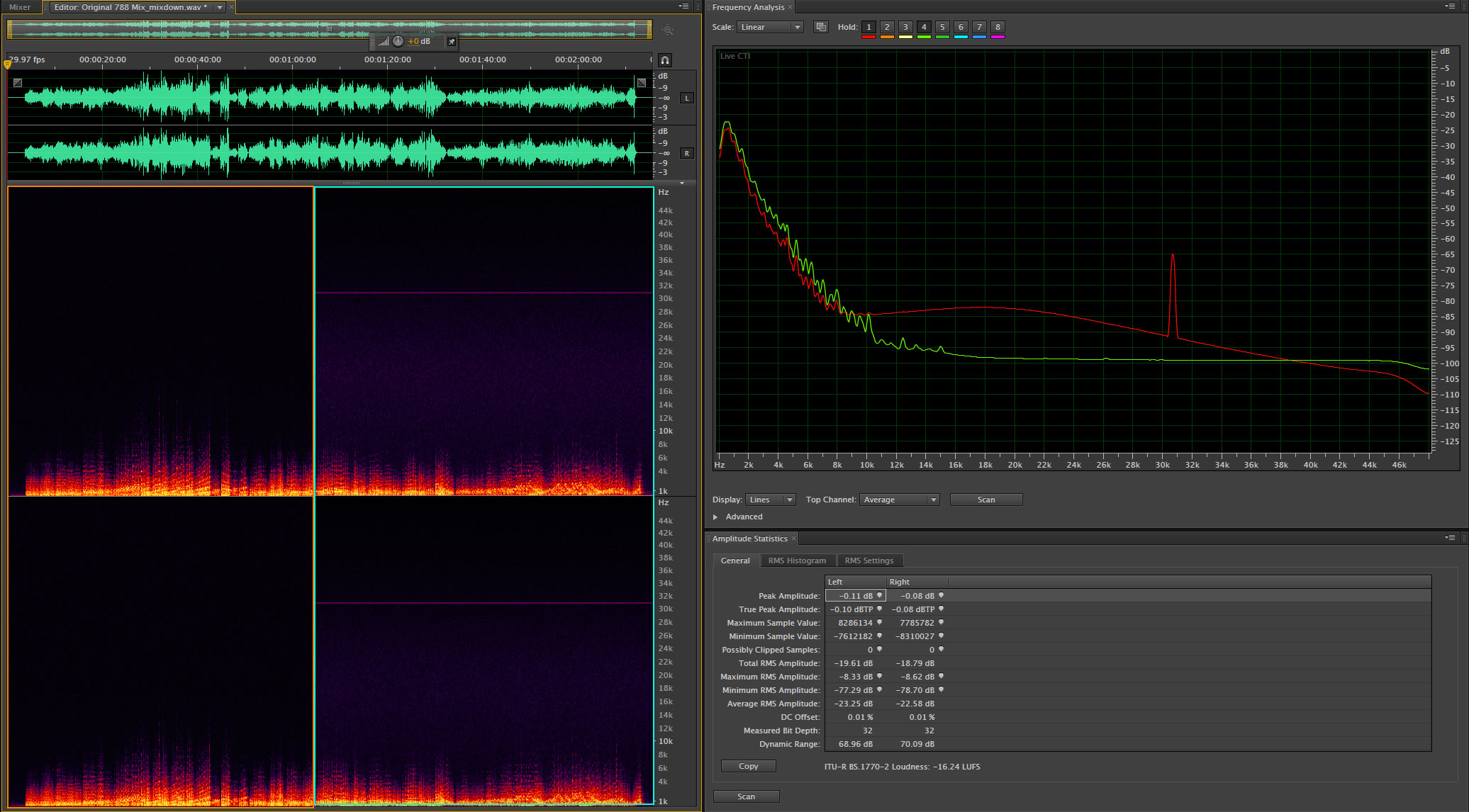No Media Is Perfect: But They’re Not All Equal – Part II
This is a continuation of yesterday’s post. Here’s a link to Part I.
However, the overarching theme of the piece is that “PCM and DSD are different and I believe complementary recording methodologies. Smart audio engineers and producers must consider both before choosing one or the other for a recording project.” I guess I’m not one of the “smart engineers” because I cannot justify using a technology that limits the sonic quality of a native recording. Why not start with something that delivers fantastic fidelity, has decades of refinements behind it, an endless list of creative and useful tools that can be used with it and a seamless delivery path to consumers.
I teach audio engineering. Next semester my students will learn about PCM AND DSD. It’s important for them to know that there are lots of formats available to them. This past semester I took my analog tape machine to the class and spent a couple of weeks on analog tape recording. If a client of theirs wants to produce using DSD, then they will need to know about it. Would I recommend they use DSD for their own projects…certainly not.
I completely agree with Steven’s statement “no media is perfect”. But I would hope that he would agree that they are not all equivalent in their ability to record and reproduce audio accurately. He argues that DSD and PCM are just two different “tool sets” that engineers and producers can use as the job dictates. I would allow analog tape in this group as it is still widely used and offers yet another popular “sonic signature” than DSD and PCM.
Last summer, I used high-resolution PCM AND analog tape to capture a live solo pianist. Contrary to Steven’s stated preference for DSD in this case…”DSD is best for live recordings of acoustic concerts”…I would never consider using DSD to capture a live concert. I simply want the most accurate recording of the performed music without the limited bandwidth and ultrasonic noise of DSD. The shortcomings of PCM are far less problematic. If a particular producer wants me to apply a LPF (low pass filter to remove the HFs) or otherwise “color” the sound that can always be done during the post production stage of the project.
Figure 1 – A spectragram showing high-resolution digital (96 kHz/24-bits) vs. analog tape. [Click to enlarge]
Current audio engineers are very fortunate to have a variety of formats to choose from when producing new recordings. Cookie Marenco prefers to record on analog tape and then transfer to DSD after all of the processing (recall there are no tools to do the things that she wants to do in the recording, editing and mixing of the audio), Morten Lynberg records to DXD (PCM) and then transcodes to a variety of DSD AND PCM flavors and I prefer to capture my projects live without overdubs to 96 kHz/24-bit PCM as multitrack projects. I would never fault anyone for making his or her own choices.
But they should be making those choices from an intelligent and informed perspective. If you know what the problems are with a particular format AND then want to employ that format for a new project then I say go for it.
Steven believes that I view DSD as a “competitor to DSD”. I couldn’t disagree more. For something to a serious competitor, it has to measure up to the best qualities of that which it is trying replace. Would you bet on a Mini Cooper to triumph over a Ferrari in a road race. They are both viable ways of getting around…but I’d take the Ferrari any day.



Did you mean to write “PCM as a competitor to DSD”?
I can’t agree with your analogy. A Mini Cooper has inferior technical specs to a Ferrari, it’s true, and -because- of this technical inferiority would lose in a race against a Ferrari. The technical specs of DSD are inferior to 96/24 PCM as you have demonstrated beyond any doubt, and yet I for one cannot hear any difference between a well-made DSD recording and well-made PCM recording because all that technical superiority lies above 20,000 Hz, and my wetware doesn’t let me hear anything much past 16,000 Hz. So even nasty ol’ RBCD gives me everything my ears can handle, and I only prefer SACD and Blu-ray because multichannel.
I’m curious — have you ever done a blind A/B test to see if you can distinguish between RBCD, hi-rez PCM, and/or DSD? I have, and the results were embarrassing: I couldn’t reliably tell any dang difference among the three, and that was using 75 tracks off over a dozen SACDs/Blu-rays. But I still enjoy multichannel, which makes an immense and immediate difference in sound quality — this A/B challenge is so easy that I get it right 100% of the time, whereas I barely exceeded 50% on my DSD v. PCM tests; i.e., I did no better than chance.
Hi Mark,
I greatly appreciate your details in regard to the difference between DSD64, DSD128 and PCM.
When I experimented with the McCormack CD, DVD-A, SACD player, it was the first one to show sonically all of the differences between the formats. True to the tutoring I got from one of the original Enlightened Audio Designs engineers, Alister Roxburgh, I indeed heard everything to be right from the DVD-A, and heard the SACD out-perform the CD except for the highs, where a well-made CD sounded more natural. He explained that DSD(64) just wasn’t set to a high enough frequency, so it needed filtering that hurt the highs.
Thanks again, Mark, for giving us so much good info, and for asking me to post this on your site.
Paul
I guess most of my fascination is in the elegance of DSD being so analog-like, in that you can look at the data and see the waveform. PCM, on the other hand, has never been explained to me in a way that allowed me to have a clear picture of how it works, so the “complexity” is interpreted in my brain as a potential for errors.
Now my question is, if we don’t give a bit of worry about the size of the file, would DSD128 or DSD256 have equivalence or any superiority to a 24/192 PCM recording, in theory or in real-world evaluation?
Paul
PS- I always try to come up with a layman’s description so both I and my clients can relate to the technology in terms of music. Because of this, I have come to the conclusion that the copying of a great analog master can be better served by a higher rez format, even though we don’t hear beyond 20k. Here’s the basis of that belief:
For redbook CD, we sample the analog music 44 thousand times each second. If we are trying to keep the recording time-accurate for everything we hear, a problem exists, even when trying to copy a simple sine wave. If, for example, an audible 10khz wave starts exactly when the sample happens, we get four “dots” to connect to draw that wave, and it works out OK, because the “dots” occur at the beginning of the wave, the positive peak of the wave, the crossing point of the wave, and the negative peak of the wave, and it looks and sounds just fine.
However, if the samples occur at a different time than the attack of the wave, connecting the dots could cause a square wave, a line, or some other “drawing” that doesn’t represent what was on the original music at all.
I submit that the value of higher sampling when copying an analog recording gives us more dots per wave, allowing it to hold a proper shape no matter what phase it was in when the sampling started. So if we want a digital copy that is true to the shape of the waveforms at least up to 20khz, the more samples the better, to make sure the highs are consistent no matter where they sit in time with the sampling.
So that’s where my layman’s brain sits. Raising the number of samples is about preserving the shape of the waveforms of the music that we can hear, not about copying frequencies beyond our hearing.
Paul…it looks like I’m going to have to write a post about sampling theory. I think I covered the basics pretty well in this post (http://www.realhd-audio.com/?p=242)…it’s worth checking.
Audio signal waveforms DO NOT have to start at the “attack” of waveform to be properly captured. According to the Nyquist Theorem, we only need 2 samples per wave cycle to perfectly reproduce the analog waveform on playback. It does require some very accurate filtering and sample timing to achieve…but designers have gotten very good at these things.
Contrary to the pseudo science that pitches the notion that DSD is somehow more “analog like” as a digitally sampled signal, it not ture. It is not possible to play a native DSD digital stream to an amplifier and speaker and get analog sound out. Digitizing is digitizing and requires converters on both ends.
Any conversion into the digital domain needs only enough resolution to capture the specifications of the source medium.
Mark, the thanks again line was supposed to be at the very end of the PS, but popped into the body of the letter, making it less coherent. See? Timing is everything! LOL